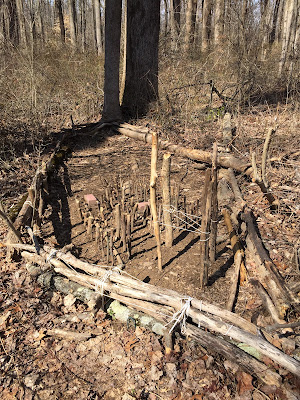There's the honey we're familiar with, and then there's another one that tastes like apricot jam. A third, produced by the stingless bee, has a fermented fruity flavor like Kambucha.
The asian honey bee (Apis cerana) produces less honey than our honey bee, but is much easier to take care of.
A Brief Account of Life in a Mountain Village in Thailand
Their first night in the village, they were surprised to be awakened at 3:30am by the robust crowing of roosters, so raucous that the whole village has little choice but to rise and begin its day. Chickens run loose, apparently free of local predators that might consume them before people have a chance to. Once a year, a tiger passes through the area, apparently without raising much concern.
The town runs on solar energy, but lest one think this mountain village an idyllic integration of humanity into nature, daytime brings cooking fires and the burning of refuse. The villagers are conditioned to the resulting stew of smoke that can linger in the valley, but it registered as noxious and toxic to Anna.
Some of the refuse is plastic, which we're all told releases toxins when burned. What plastics do the villagers have if they grow their own food and have few possessions? Though they cook delicious meals most days, there are times when villagers may not feel like cooking, and so pull out store-bought noodles and tomato sauce, the plastic wrappings from which end up getting burned in the refuse pile.
This is not much different from my own experience growing up in a small village in Wisconsin in the 1960s. One of my chores was to burn the garbage, plastic and all. In autumn, we'd rake some leaves into piles to jump into, and others into piles to burn. We'd toss acorns into the glowing core of the fire and wait for the popcorn-like explosion. On brisk, sunny fall days, the whole village became suffused with what registered as a sweet and endearing aroma of burning leaves. Even after moving to a city, the 1930s house we moved into had an incinerator in the basement for burning trash. And in the 70s and 80s, when I played jazz gigs in smoke-filled bars, it was not until the next morning that I'd notice the wretched smell of stale smoke in the clothes I had worn.
There have been efforts to promote cleaner air in remote mountain villages around the world. Some students, before entering Princeton University, sign up to spend a "bridge year" in a foreign country doing good deeds, one of which is helping build cleaner burning stoves for villagers in Peru and elsewhere. You'd think the villagers would be grateful for a home less choked with smoke, and maybe they are, but the capacity of the body to become conditioned to abuse is both impressive and exasperating.
Lots of interesting reading out there on bees. Here's some info about eight species of honey bees around the world.


















































